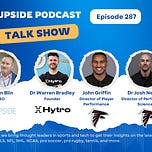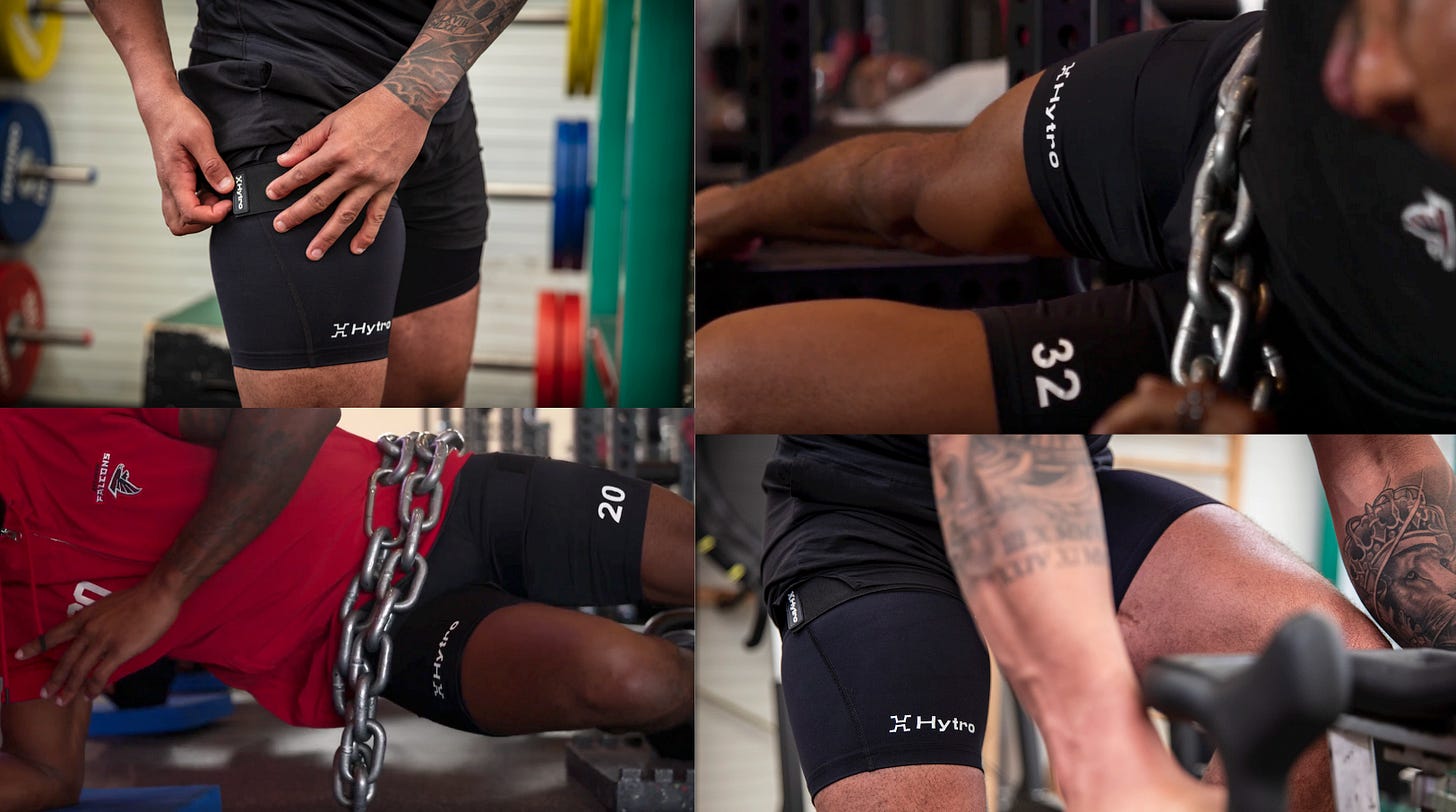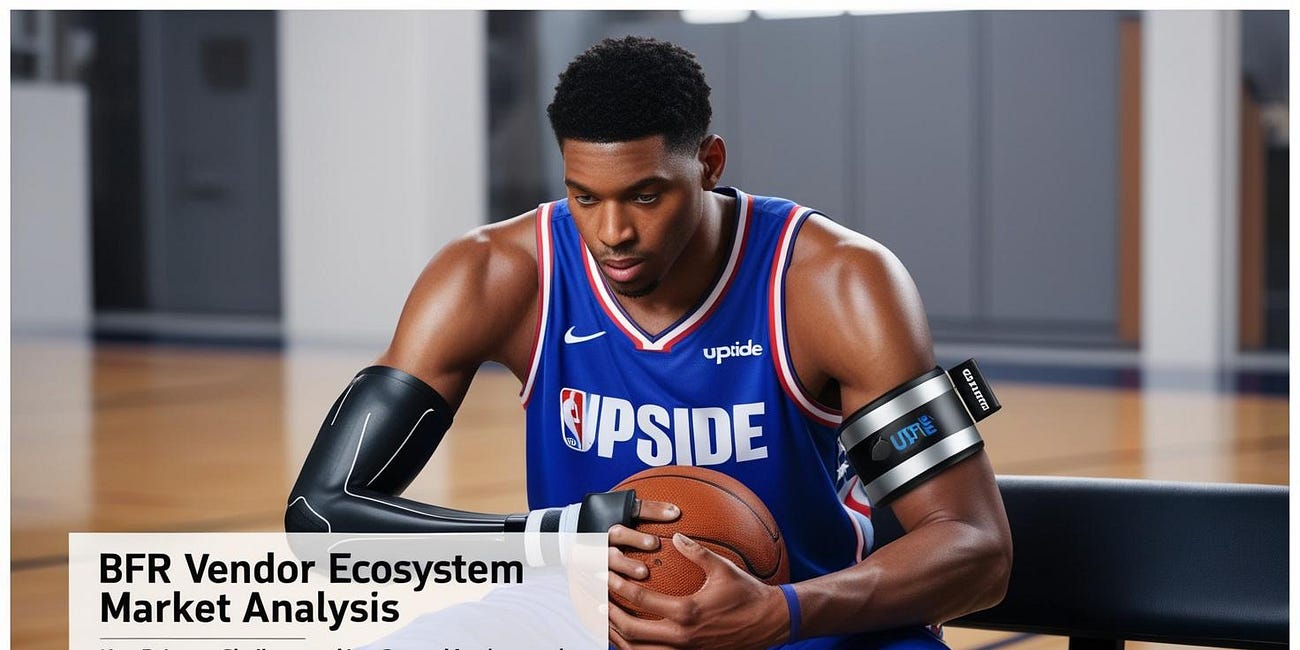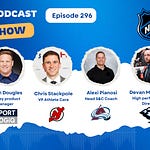This week we have the honor to interview a group of NFL sports performance executives to talk about the latest trends in the world of BFR in the NFL.
John Griffin, Director of player Performance, Atlanta Falcons (NFL).
Dr Josh Nelson (Nelly), Director of Performance Science, Atlanta Falcons (NFL).
Dr Warren Bradley, Founder, Hytro.
📝Show Notes: Through this interview, we touched on the best practices related to:
BFR Best Practices & Customization
BFR Trends in Application: Performance vs. Recovery
Integrating BFR into the Rehab Continuum
Practical & Safety Barriers in an NFL Environment
Future of BFR & Research Gaps
You can watch the video interview below by clicking on the Youtube link. You can also listen to the audio interview by clicking on the link at the top of the page:
Here are some pictures of Atlanta Falcons players wearing the Hytro BFR short:
Here are some of the best quotes of our conversation with John, Nelly and Warren:
1. Best Practices & Customization
Dr. Warren Bradley:
“When it comes to protocols, pressures, and rep ranges, the truth is there’s no single formula that fits everyone. You’ll find countless variations in the literature — different cuff widths, pressures, and set/rep schemes — but in practice, the most effective approach is the one that meets the athletes and coaches where they are. It’s about making BFR fit seamlessly into an existing performance or recovery program, not forcing a program to fit BFR. That’s actually why we started working closely with the Falcons — we found that flexible middle ground, meeting them where their players and staff were, and adapting our approach to the realities of the NFL environment. That’s where the real-world results come from.”John Griffin:
“In our setting, we’re using BFR primarily as a recovery tool right now, especially early in the season. Our schedule is highly cyclical — you play every week, so recovery becomes a premium commodity. Getting players’ tissue to turn over and legs back under them is both a science and an art. Every team has its own rhythm and approach, but for us, BFR plays a key role in post-game recovery. Later in the season, as the schedule tightens and total load starts to accumulate, we’ll use it as a deloading stimulus — maintaining strength and conditioning while reducing external load. But right now, recovery is king.”Dr. Josh Nelson (Nelly):
“When we arrived last year, we initially experimented with some of the more traditional electronic units like the Delphi system. Those work great for precision, but they’re hard to scale across an entire NFL roster. That’s when we started working with Warren to explore wearable options that were more portable and flexible. The wearable system allows us to get the benefits of BFR without needing a clinician present every time. It’s simple, efficient, and scalable — we can literally roll it out to the entire team, which is crucial in a high-performance environment with 50+ athletes.”
2. Trends in Application: Performance vs. Recovery
John Griffin:
“We’re using BFR in some non-traditional ways, especially around aerobic and recovery work. Right now, we’re emphasizing unloaded conditioning — bikes have been a huge part of that. We’ll have players go through steady-state aerobic sessions, eight to ten minutes under consistent occlusion, or alternate between higher-intensity bouts and rest. It’s about maintaining cardiovascular conditioning and tissue quality without overloading their joints and muscles. In-season, we’re not chasing hypertrophy — we’re fighting atrophy and trying to maintain strength. So instead of stacking heavy volume, we’ll do things like Spanish squats, split squats, or goblet-loaded movements under BFR. The load is lighter, but the stimulus is significant, and it keeps our athletes strong throughout a long, punishing season.”Dr. Josh Nelson (Nelly):
“We’ve got guys who do absolutely everything right — the ones who chase every 1% gain possible. For them, BFR has become one of those small edges. The beauty of the wearable system is that they can take it home or on the road and build it into their own recovery routines. We’ve even used it during travel — cross-country flights, home use, wherever it fits. It’s a highly scalable tool that gives athletes autonomy while still providing a measurable recovery benefit.”Dr. Warren Bradley:
“If you zoom out beyond football, what’s really exciting is how BFR is being used across sports — not just for hypertrophy, but for solving very specific problems. You’ll see it used for tendinopathies, as a pre-conditioning tool before a match, or even to manage soreness and tissue recovery. It’s not a one-size-fits-all tool; it’s a versatile intervention that can be tailored to the specific demands of the athlete and the phase of the season they’re in.”
3. Integrating BFR into the Rehab Continuum
John Griffin:
“BFR has really helped us bridge that gap between the medical and performance sides. Early in the rehab process, it’s about mitigating atrophy when a guy can’t load — especially post-surgery or after long immobilization periods. As athletes progress into later stages of rehab or return-to-play, we use BFR strategically to keep loading low while still creating a meaningful training stimulus. For example, if a player’s coming off an ACL and starting to rejoin practice, we’ll extend the BFR window a bit longer to avoid stacking multiple high-stress loads on the same day. That way, he’s getting stronger and reconditioning tissue without overloading his system during reintegration.”Dr. Warren Bradley:
“Clinically, we’re seeing BFR being used as soon as two or three days post-op — once the wound is closed and the athlete is medically cleared. Passive BFR at that stage stimulates hormonal pathways and keeps the tissue in a responsive state, even before active rehab begins. It offsets atrophy dramatically. But it’s important to match the technology to the phase of rehab. In early rehab, precision matters, so a digital device like Delphi gives you that exact occlusion percentage. Later on, when athletes move to self-managed work or home rehab, that’s when wearables become invaluable. You can’t send a $10,000 Delphi home with a player — but you can send a lightweight, wearable cuff that they can use independently and safely.”Dr. Josh Nelson (Nelly):
“One interesting thing we’ve been doing is using BFR on the non-injured limb if a player’s injured on one side. There’s a systemic hormonal effect — if you train one limb under occlusion, the increased growth factors and hormonal response still circulate throughout the body. So even though you’re only training one leg, the injured side gets some benefit too. It’s a creative way to keep athletes engaged and physically progressing without overloading the injured area.”
4. Practical & Safety Barriers in an NFL Environment
John Griffin:
“Education and trust are everything. You can’t just hand an athlete a device and say, ‘This will help you.’ You have to explain why it works, how it’s used safely, and what outcomes they can expect. Our approach has been to build a professional network, constantly stay up to date with new research, and lean on experts like Warren who’ve been living and breathing BFR for years. From a staff standpoint, we emphasize continuing education and certification where possible. And we keep the athletes involved in the learning process — because once they understand and trust the method, buy-in is easy.”Dr. Warren Bradley:
“For us, the relationship doesn’t end once we provide the product. We’re very intentional about staying connected with coaches and practitioners — getting their feedback, seeing what works and what doesn’t, and adjusting together. The most valuable insights come from those real-world feedback loops. It’s not just about research; it’s about collaboration, problem-solving, and ensuring safety and effectiveness at scale.”Dr. Josh Nelson (Nelly):
“At the end of the day, our environment is chaotic — you’ve got limited time, multiple demands, and players in different physical states. So whatever you implement has to be consistent, quick, and scalable. That’s where simplicity and education come in. If it’s not practical week to week across the whole roster, it won’t last.”
5. Future of BFR & Research Gaps
John Griffin:
“Mainstream adoption is the next big step. The more exposure athletes have to BFR and the more often they see it being used, the easier it becomes for them to trust it. When something’s new or unfamiliar, there’s always hesitation. But once they see it used across teams and leagues, that trust barrier disappears. From a performance perspective, I’m particularly interested in how BFR influences tendon adaptations — things like cross-sectional area and fascicle length. We still don’t fully understand those morphological changes, and that’s a fascinating space for future research.”Dr. Josh Nelson (Nelly):
“Every time we bring in a new system or technology, I immediately think about scalability — how do we make this work across the entire roster and across a long season? How do we match the right protocol to the right stressor? A high-speed day might call for one recovery pattern, a heavy-contact day another. We’ve even talked with Warren about pairing BFR with cold-water immersion — combining occlusion with hydrotherapy to see if that accelerates recovery. That’s where the field is going: strategic pairing of stress and recovery.”Dr. Warren Bradley:
“If you search PubMed right now, you’ll find over 13,000 studies on BFR — but about 95% of them are in rehab or elderly populations. The big gap is elite performance. The exciting part is that we’re finally seeing an explosion of research into areas like passive recovery, ischemic preconditioning, tendon health, and endurance adaptations. Coaches like John and Nelly are pushing the boundaries — using BFR in ice baths, saunas, even at altitude. We’re now doing the research to validate what they’re discovering in the field. And honestly, that’s the best part — practitioners are driving innovation, and the science is racing to keep up.”
You may also like:
💙 Upside Analysis: Blood Flow Restriction (BFR) Vendor Ecosystem Market Analysis: Key Drivers, Challenges, Stats, Use Cases, Vendors, Recommendations to Teams
Blood Flow Restriction (BFR) training has evolved from a fringe rehabilitation tool to a widely adopted, research-backed modality across elite sports, military, and clinical environments. The method involves applying external pressure—usually via cuffs or straps—to restrict venous return while maintaining arterial inflow. This creates a hypoxic environm…
🔥Upside NFL Group Chat with Ted Rath (New Orleans Saints), Roderick Moore Jr (Pittsburgh Steelers), Ryan Juarez (Washington Commanders)
This week we have the honor to interview a group of NFL sports performance executives to talk about the latest trends in the world of sports performance, load management, sleep/recovery management, rehabilitation and data & wearable tech integration, and mental performance in the NFL.














